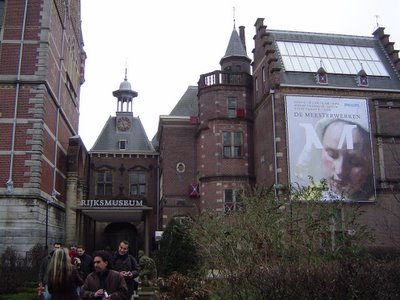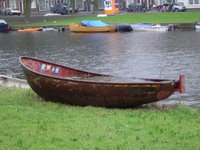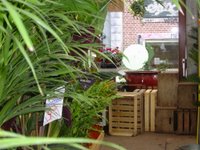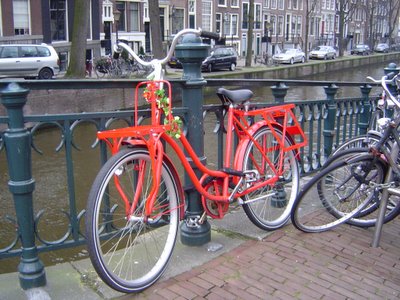 Duvven & Trekken (day 1)
Duvven & Trekken (day 1).

I slept for something like 16 hours. I spent a leisurely morning trying to warm up over breakfast at Bagels & Beans, then walked the rest of the way to the Museumplein and the Rijksmuseum. The museum is under renovation, and only selections from the collection are available, but they were well-chosen and, honestly, were just enough Dutch Masters and Delftware for one day; more would have been too much. Like everyone, I snapped pictures of the entrance, but I also took a few finger-numbing minutes looking around the garden outside, where I noticed this waterspout and other details of the building.

Two things distinguish the
William Rex, a 4 1/2 meter long model of a Dutch warship, built in the late 1600's: first, the incredible level of detail, and second, the fact that there was never a ship called the William Rex, the model was built to show off and pay homage to William of Orange.
If model ships were how the men showed off, the women built
enormous dollhouses, models of their own homes. The most famous was built by Prunella Oortman just before her marriage to a silk merchant, and is an exact scale replica of her home, down to the porcelain. It cost as much as a real canal house. To give you a sense of the scale, the Rijksmuseum has set up a staircase, rising maybe five feet, to a little platform where visitors can stand to see the upper stories of the house.

And here are a few more of my favorite pieces from the museum - a porcelain birdcage, a flirtatious statue of "
Menacing Love" by Etienne-Maurice Falconet, a surprisingly modern 17th century painting of "
The Threatened Swan" by Jan Asselign. Text was added later to the painting, labeling the attacking dog "foreign enemies," the eggs in the nest "Holland," and the swan "the pensionary," refering to Johan de Witt, whose name meant "white" and whose coat-of-arms included a swan.

Nowadays, we would shudder at the thought of a later owner adding inscriptions to a piece of fine art, and I do think the painting was better off without; nevertheless, one thing that I thought of over and over again in Amsterdam is how people of every time period make choices about what to preserve, to alter, to destroy. Buildings that we now find fascinating were reviled in their day, neighborhoods developed, artwork and architecture altered. If you live in such an old city, I guess you see regular examples of how the old must make way for the new, what is old to us now was new once, and yet you also see the value in preserving what you can, for the sake of beauty and history.
Both in the Rijksmuseum and later in Rembrandt's house, I saw examples of towering tulip vases, made of interlocking porcelain pagodas, which were interesting enough by themselves, but would have been fascinating to see filled with flowers. Quite a different way of displaying flowers than we prefer today. (Reading my mind, the Rijksmuseum has a photograph of the largest of these
pyramid vases filled with red tulips... I am still trying to imagine this in the setting of a grand canal house).
And of course, in the last room of the Rijksmuseum, "
The Night Watch", which, I learned, probably was not set at night but was named later as the canvas darkened. Even after it was restored (it still looked dark to me), the name stuck. After seeing Rembrandt's portraits, and paintings of civic brigades by other artists, I kept glancing at the faces of Dutch men on the street, looking for similarities to the faces portrayed in these paintings, the beards, the hair - the styles and fashions in these portraits are so distinctive, I was looking for continuity. What would we look like today if we had portraits painted by 17th century artists? Which is all a compliment to Rembrandt's ability to capture individuals, even in a group portrait.
From the Rijksmuseum, I wandered along Prinsengracht to the
Anne Frank Huis, the "secret annex" where Anne and her family hid during World War II. I liked Prinsengracht best of all the streets and canals I saw in Amsterdam, partly because of the elegant houses and cobblestoned streets on either side, partly because it was the first place I could reliably recognize, an orientation-point, partly because I like the word,
the prince's canal, named for William, Prince of Orange.
The house is easy to miss, as it is encased in a modern glass building which protects it and provides space for a cafe and additional museum exhibits. The tour is simple and direct, including basic biographical information about Anne Frank and her family, a walk through the various rooms of the house, and excerpts from the diary. There are models showing how the house might have been furnished at the time the Frank family lived there, and cases containing historical documents (the notice calling Margot Frank to a work-duty, which precipitated the family's move into hiding, popular magazines of the time, photographs of the family and those who helped them). You can see the postcards, magazine clippings, and photographs which Anne glued to her bedroom wall to make her room feel more like home. The exhibit ends with images of concentration camps and a short video about what happened to Anne, a childhood friend's story of throwing a parcel of food to her over the fence in Bergen-Belsen just days before Anne died.
The museum has another, modern, multi-media exhibit about fundamental freedoms, which presents short MTV-style videos about recent controversies, poses a question, and then asks viewers to vote using buttons in the amphitheater. One of the more interesting pieces asked whether Orange Order groups should be able to
march through Catholic neighborhoods in Northern Ireland, when this has led to violence in the past. It pits one's commitment to freedom of speech and assembly against one's commitment to public safety and to protecting people from "fighting words."
I had a delicious Dutch pancake (with cheese, sunflower seeds, and a little salad in the middle) and a slice of apple pie with cinnamon ice cream, then bought a ticket to see the Subways at
Melkweg, a local concert venue-movie theater-art gallery-theater. I had heard of the Subways, a British rock band, though I couldn't remember what kind of music they played, but it seemed like fun to take a chance on a new band and in a new city, too... the opening act was a very quiet, alt-country (Americana?) singer named Jeff Caudill, formerly of a band called Gameface. It was a little bland, but not bad, but a lot of the audience was talking very loudly throughout the set, and several girls came and stood right in front of me and proceeded to talk very loudly and just kind of bump into everyone around them. I didn't want to say anything (not least because I would have to say it in English, and while the Dutch do, more-or-less universally, understand English, it seemed all the more awkward) but I did want to hear the music, so eventually, I asked them if they didn't mind being a bit quieter. One girl was very rude to me, then later apologized somewhat flippantly and promised to be quiet during the Subways.

And that is how I ended up in the middle of a Dutch mosh pit. Jeff Caudill was nothing like the Subways, I have no idea why he was selected to open this show, but the audience's reaction to his music made a lot more sense once
the Subways came on and began playing their loud, jump around, crowd-surfing rock & roll. Here's
No Goodbyes in QuickTime. (I still wish people would be more polite -
nothing excuses talking loudly during a set). Charlotte is an amazing, waif-like, as a Dutch entertainment magazine put it (although they might have spelled it differently), "rockchick." She and Billy, the lead singer, would stand, forehead to forehead, in moments of electric intimacy during pauses between explosions of sound. They jumped up and down, led the audience in clapping and singing along. Bouncing around with the crowd, I realized I should go to far more loud rock concerts. Note that, like raisins in a cereal box, those of us who are smaller (in stature or enthusiasm for crowd-surfing) filter towards the edges and back of the room...
Sweaty and exhilarated, I hopped on the tram home (and was even asked for directions, which I could not give, of course, to Rembrandtstraat).












































